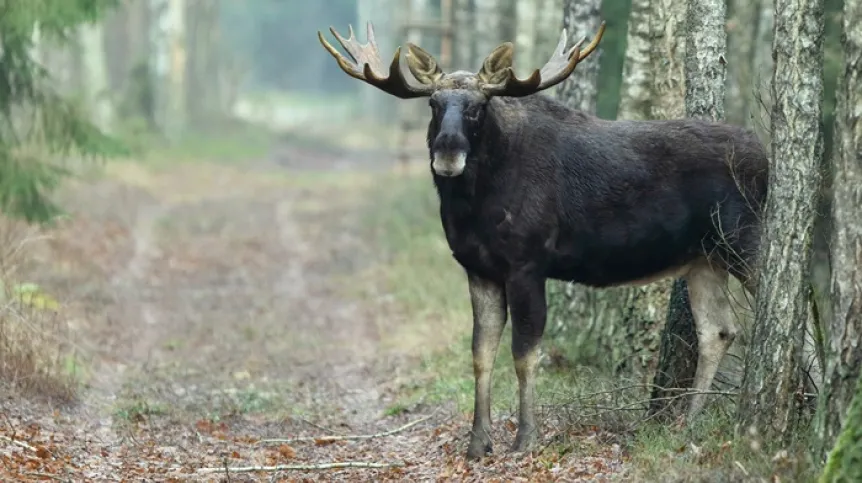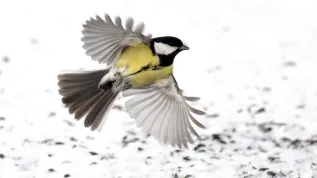
In Poland, we now can more often observe male moose with palmated, 'shovel-shaped' antlers. This is the result of the moose hunting ban in force since 2001. Researchers confirmed it by analysing photos posted on social media.
Since 2001, there has been a moose hunting ban in Poland - introduced to save the species which was being wiped out. The lack of hunting resulted in the return of moose to formerly inhabited areas of the country and a gradual increase in their numbers. Males with 'shovel-shaped', palmated antlers are now more often spotted. Scientists, in collaboration with nature photographers, decided to check how the form and size of moose antlers changed during the hunting ban.
'The moose is one of the largest animals in Europe and a very charismatic species. It attracts the attention of not only nature lovers, but also casual observers. This powerful animal, taller than a horse, has an elongated head ending with powerful nostrils, and in the case of males also impressive antlers, which arouses admiration, and sometimes even fear. Its resurgent population increases the chances of encountering a moose in its natural environment, even in areas where this species has been absent for decades. The moose has become a popular subject of nature photography, and its antlers, cast every year, are desired by many collectors. There are groups on social media (e.g. on Facebook: Jestem z łosiem or Rosochy łosia cała Polska) that share photos of both animals and cast antlers', the authors of new research on moose write in a press release.
Scientists from the Mammal Research Institute of the Polish Academy of Sciences in Białowieża and the Białystok University of Technology decided to use photos provided by nature photographers and employees of national parks, and photos available on social media, to trace changes in the form and size of moose antlers during the period of the moose hunting ban (moratorium).
They published the results of this research in the European Journal of Wildlife Research.
For each photo, the researchers defined the year of the antler growth, the region where the photo was made, and the form of the antlers according to the following groups: cervine (with few rough and long tines, but no flattenings), intermediate (antlers with flattenings or narrow palms and long tines), and palmated (distinct palm with short tines). Additionally, the number of tines on one of the antler branches was counted, as well as the antler size index, measured as the ratio between maximum spread of antlers (in pixels measured in IrfanView software) and the width of head (in pixels) below the antler base. The antler form, size and the number of tines are the parameters taken into account when analysing the antler sizes of various deer species, including moose.
The analysis of antler forms was limited to the period after 2012 because palmated antlers had not been observed before.
As a result of painstaking work, the scientists collected 1,371 photos of male moose or cast antlers from 2005-2021. The number of available photos increased from year to year, which was probably due to the rebuilding moose population and the development of social media dedicated to moose, they suggest.
Analyses show that the probability of observing males with the weakest, cervine antlers, decreased during the moratorium from 47 percent in 2012 to 28 percent in 2021; the share of males with intermediate antlers increased over the same period from 44 percent to 53 percent, and palmated - from 9 percent to 19 percent. The average number of antler tines also increased significantly: from 3.2 in 2005 to 4.7 in 2021. The antler size index also changed, increasing on average from 3.4 to 3.9, say the researches.
'If we look at the maximum values, these differences are much more pronounced, because at the beginning of the period covered by the analysis, the number of tines in moose antlers did not exceed 5, and at the end it reached 11, while the antler size index rarely exceeded 4 at the beginning of the moratorium, when after 2020 it could even exceed 7. If we convert these values based on measurements of the width of moose skulls into actual sizes, the maximum size of moose antlers in the analysed period has changed from 75 cm to over 140 cm’, says the press release.
'The most likely mechanism behind the observed changes could be the ageing of a population released from hunting pressure. The largest antlers are observed for males of 9-11 years, the age males could rarely reach before the ban, because the selection rules permitted shooting males with cervine antlers with a maximum of 4 tines, i.e. quite young animals. A gradual change occurred only a few years after the ban was introduced. Interestingly, it also turned out that the typical form of moose antlers in Poland is not the cervine antler, as was believed for decades, but rather the intermediate antler, which currently dominates among males, although beautiful palmated antlers are also increasingly observed', says Professor Rafał Kowalczyk from the Mammal Research Institute at the Polish Academy of Sciences in Białowieża, the originator of the research project, who has been researching this species for over a dozen years.
Significant regional antler size variations were also observed, likely due to differences in environmental conditions and diet quality. The smallest antlers were observed in males in newly recolonised areas, which was probably related to the young age of the colonising individuals, and in the Biebrza River area, where poorer environments dominate, especially in the winter moose refuges, and moose populations occur at higher densities. The largest antlers were observed in male moose in Warmia and Mazury and Polesie, the areas with diverse environments and a rich food base.
'Our study is an interesting example of using citizen science, because in our analyses we used photos posted on social media to track ecological trends and the impact of game management on wildlife. The growing interest in nature and more frequent visits to wilderness combined with the development of photo equipment and social media results in higher participation of citizen science in wildlife monitoring. In the case of charismatic species such as the moose, being a subject of nature photography and collection of cast antlers, it is possible to collect a large amount of data allowing for interesting research', says Professor Kowalczyk.
The authors of the study add that their research has important implications for management of moose populations, especially in a situation of growing pressure from hunters and foresters, and even some local government officials, to resume hunting this species due to growing conflicts.
'Trophies are one of the important reasons for hunting, especially since in recent years we have seen an increase in the share of palmated antlers, particularly desired by hunters. The opening of moose hunting will not only affect their numbers, but also their behaviour, because they will become much more timid. This will reduce the possibility of observing these charismatic animals, which is of great importance for the development of tourism, especially in the main areas where the species occurs: Biebrza, Polesie and Kampinos, where moose are a huge attraction and a tourist magnet. Hunting can also reverse the trend of changes in antler size, which plays a significant role in competition between males during the mating season and is important for their reproductive success', the researchers write.
PAP - Science in Poland
zan/ bar/ kap/
tr. RL













